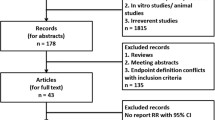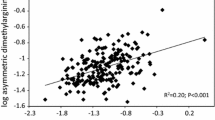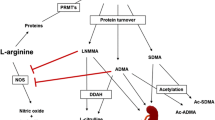Abstract
l-Arginine is the substrate of endothelial nitric oxide (NO) synthase forming NO which inherits various biological cardio-protective functions. The dimethylarginines asymmetric (ADMA) and symmetric dimethylarginine (SDMA) can impair the synthesis of NO and are elevated in patients with cardiovascular disease, including heart failure (HF). We investigated the association between dimethylarginines and HF risk in a case-cohort study of the European Prospective Investigation into Cancer and Nutrition (n = 27,548), comprising a random subcohort (n = 2224 including 19 HF cases), and all remaining HF cases (n = 176) that occurred within 8.3 years of follow-up. Serum concentrations of dimethylarginines were measured using liquid chromatography-tandem mass spectrometry. Hazards ratios (HRs) and 95% confidence intervals (CI) were estimated across quartiles and per doubling of ADMA and SDMA concentrations using Cox’s proportional hazards regression. After multivariable adjustment, each doubling of ADMA was associated with a 60% higher HF risk (HR [95% CI] 1.60 [1.10–2.31]). Between SDMA and HF risk a U-shaped association was observed (HR [95% CI] for the second, third and fourth quartile compared to the first: 0.52 [0.33–0.82], 0.63 [0.40–0.99], and 0.71 [0.46–1.10], p for nonlinearity <0.01). We provide substantiated evidence for a relationship between ADMA and cardiovascular endpoints. In addition to the established relation between ADMA and myocardial infarction, our findings indicate a positive association between ADMA and HF incidence in persons without apparent myocardial infarction. Targeting the ADMA metabolism might open up new therapeutic perspective for HF prevention and treatment. Further investigations are needed to shed more light on mechanisms involved in the pathogenesis of HF related to elevated ADMA levels.

Similar content being viewed by others
Abbreviations
- ADMA:
-
Asymmetric dimethylarginine
- CAT:
-
Cationic amino acid transporter
- CI:
-
Confidence interval
- CVD:
-
Cardiovascular disease
- eNOS:
-
Endothelial nitric oxide synthase
- EPIC:
-
European Prospective Investigation into Cancer and Nutrition
- hArg:
-
Homoarginine
- HF:
-
Heart failure
- HR:
-
Hazards ratio
- ICD-10:
-
International Classification of Diseases, 10th revision
- iNOS:
-
Inducible NOS
- IQR:
-
Interquartile range
- MI:
-
Myocardial infarction
- NMMA:
-
N-Monomethylarginine
- NO:
-
Nitric oxide
- PRMT:
-
Protein arginine methyltransferase
- SD:
-
Standard deviation
- SDMA:
-
Symmetric dimethylarginine
- SE:
-
Standard error
References
Achan V, Broadhead M et al (2003) Asymmetric dimethylarginine causes hypertension and cardiac dysfunction in humans and is actively metabolized by dimethylarginine dimethylaminohydrolase. Arterioscler Thromb Vasc Biol 23(8):1455–1459
Atzler D, Mieth M et al (2011) Stable isotope dilution assay for liquid chromatography-tandem mass spectrometric determination of L-homoarginine in human plasma. J Chromatogr B Analyt Technol Biomed Life Sci 879(23):2294–2298
Atzler D, Schwedhelm E et al (2015) L-homoarginine and cardiovascular disease. Curr Opin Clin Nutr Metab Care 18(1):83–88
Bauersachs J, Widder JD (2008) Endothelial dysfunction in heart failure. Pharmacol Rep 60(1):119–126
Bergmann MM, Bussas U et al (1999) Follow-up procedures in EPIC-Germany–data quality aspects. European Prospective Investigation into Cancer and Nutrition. Ann Nutr Metab 43(4):225–234
Boeing H, Wahrendorf J et al (1999) EPIC-Germany–A source for studies into diet and risk of chronic diseases. European Investigation into Cancer and Nutrition. Ann Nutr Metab 43(4):195–204
Boger RH (2006) Asymmetric dimethylarginine (ADMA): a novel risk marker in cardiovascular medicine and beyond. Ann Med 38(2):126–136
Drexler H (1999) Nitric oxide synthases in the failing human heart: a doubled-edged sword? Circulation 99(23):2972–2975
Drexler H, Kastner S et al (1998) Expression, activity and functional significance of inducible nitric oxide synthase in the failing human heart. J Am Coll Cardiol 32(4):955–963
Duckelmann C, Mittermayer F et al (2007) Asymmetric dimethylarginine enhances cardiovascular risk prediction in patients with chronic heart failure. Arterioscler Thromb Vasc Biol 27(9):2037–2042
Haywood GA, Tsao PS et al (1996) Expression of inducible nitric oxide synthase in human heart failure. Circulation 93(6):1087–1094
Kiechl S, Lee T et al (2009) Asymmetric and symmetric dimethylarginines are of similar predictive value for cardiovascular risk in the general population. Atherosclerosis 205(1):261–265
Kroke A, Klipstein-Grobusch K et al (1999) Validation of a self-administered food-frequency questionnaire administered in the European Prospective Investigation into Cancer and Nutrition (EPIC) Study: comparison of energy, protein, and macronutrient intakes estimated with the doubly labeled water, urinary nitrogen, and repeated 24-h dietary recall methods. Am J Clin Nutr 70(4):439–447
Krzyzanowska K, Mittermayer F et al (2007) Asymmetric dimethylarginine predicts cardiovascular events in patients with type 2 diabetes. Diabetes Care 30(7):1834–1839
Maas R, Dentz L et al (2007) Elevated plasma concentrations of the endogenous nitric oxide synthase inhibitor asymmetric dimethylarginine predict adverse events in patients undergoing noncardiac surgery. Crit Care Med 35(8):1876–1881
Mann DL, Bristow MR (2005) Mechanisms and models in heart failure: the biomechanical model and beyond. Circulation 111(21):2837–2849
Maxwell AJ (2002) Mechanisms of dysfunction of the nitric oxide pathway in vascular diseases. Nitric Oxide 6(2):101–124
McMurray JJ, Adamopoulos S et al (2012) ESC guidelines for the diagnosis and treatment of acute and chronic heart failure 2012: The Task Force for the Diagnosis and Treatment of Acute and Chronic Heart Failure 2012 of the European Society of Cardiology. Developed in collaboration with the Heart Failure Association (HFA) of the ESC. Eur J Heart Fail 14(8):803–869
Papageorgiou N, Androulakis E et al (2015) Homoarginine in the shadow of asymmetric dimethylarginine: from nitric oxide to cardiovascular disease. Amino Acids 47(9):1741–1750
Pilz S, Edelmann F et al (2014) Associations of methylarginines and homoarginine with diastolic dysfunction and cardiovascular risk factors in patients with preserved left ventricular ejection fraction. J Card Fail 20(12):923–930
Prentice RL (1986) A case-cohort design for epidemiologic cohort studies and disease prevention trials. Biometrika 73(1):1–11
Riboli E, Hunt KJ et al (2002) European Prospective Investigation into Cancer and Nutrition (EPIC): study populations and data collection. Public Health Nutr 5(6B):1113–1124
Saitoh M, Osanai T et al (2003) High plasma level of asymmetric dimethylarginine in patients with acutely exacerbated congestive heart failure: role in reduction of plasma nitric oxide level. Heart Vessels 18(4):177–182
Schwedhelm E, Maas R et al (2007) High-throughput liquid chromatographic-tandem mass spectrometric determination of arginine and dimethylated arginine derivatives in human and mouse plasma. J Chromatogr B Analyt Technol Biomed Life Sci 851(1–2):211–219
Schwedhelm E, Wallaschofski H et al (2014) Incidence of all-cause and cardiovascular mortality predicted by symmetric dimethylarginine in the population-based study of health in pomerania. PLoS ONE 9(5):e96875
Seljeflot I (2012) Plasma asymmetric dimethylarginine in patients with acute decompensation of chronic heart failure. Heart 98(11):831–832
Sibal L, Agarwal SC et al (2010) The role of asymmetric dimethylarginine (ADMA) in endothelial dysfunction and cardiovascular disease. Curr Cardiol Rev 6(2):82–90
Siegerink B, Maas R et al (2013) Asymmetric and symmetric dimethylarginine and risk of secondary cardiovascular disease events and mortality in patients with stable coronary heart disease: the KAROLA follow-up study. Clin Res Cardiol 102(3):193–202
Strobel J, Mieth M et al (2012) Interaction of the cardiovascular risk marker asymmetric dimethylarginine (ADMA) with the human cationic amino acid transporter 1 (CAT1). J Mol Cell Cardiol 53(3):392–400
Tsikas D, Wu G (2015) Homoarginine, arginine, and relatives: analysis, metabolism, transport, physiology, and pathology. Amino Acids 47(9):1697–1702
Vallance P, Leiper J (2004) Cardiovascular biology of the asymmetric dimethylarginine:dimethylarginine dimethylaminohydrolase pathway. Arterioscler Thromb Vasc Biol 24(6):1023–1030
Visser M, Paulus WJ et al (2010) The role of asymmetric dimethylarginine and arginine in the failing heart and its vasculature. Eur J Heart Fail 12(12):1274–1281
Weikert C, Stefan N et al (2008) Plasma fetuin-a levels and the risk of myocardial infarction and ischemic stroke. Circulation 118(24):2555–2562
Willeit P, Freitag DF et al (2015) Asymmetric dimethylarginine and cardiovascular risk: systematic review and meta-analysis of 22 prospective studies. J Am Heart Assoc 4(6):e001833
Wirth J, Buijsse B et al (2014) Relationship between N-terminal pro-brain natriuretic peptide, obesity and the risk of heart failure in middle-aged German adults. PLoS One 9(11):e113710
Acknowledgements
We thank the Human Study Centre (HSC) of the German Institute of Human Nutrition Potsdam-Rehbruecke, namely the trustee and the data hub for the processing, and the participants for the provision of the data, the biobank for the processing of the biological samples and the head of the HSC, Manuela Bergmann, for the contribution to the study design and leading the underlying processes of data generation. We gratefully thank Mariola Kastner and Anna Steenpaß for their excellent technical assistance. This study was funded by a research Grant provided by the DZHK to CW, DA, and ES (Grant number 81X2710108). DA acknowledges the support of the European Union under a Marie Curie Intra-European Fellowship for Career Development.
Author information
Authors and Affiliations
Corresponding author
Ethics declarations
Conflicts of interest
The authors declare that they have no conflict of interest.
Ethical approval
All procedures performed in studies involving human participants were in accordance with the ethical standards of the institutional and/or national research committee and with the 1964 Helsinki declaration and its later amendments or comparable ethical standards. This article does not contain any studies with animals performed by any of the authors.
Informed consent
Informed consent was obtained from all individual participants included in the study.
Additional information
Handling Editor: C.-A. A. Hu.
Electronic supplementary material
Below is the link to the electronic supplementary material.
Rights and permissions
About this article
Cite this article
Wirth, J., Atzler, D., di Giuseppe, R. et al. Higher serum asymmetric dimethylarginine is related to higher risk of heart failure in the EPIC-Potsdam study. Amino Acids 49, 173–182 (2017). https://doi.org/10.1007/s00726-016-2348-3
Received:
Accepted:
Published:
Issue Date:
DOI: https://doi.org/10.1007/s00726-016-2348-3




